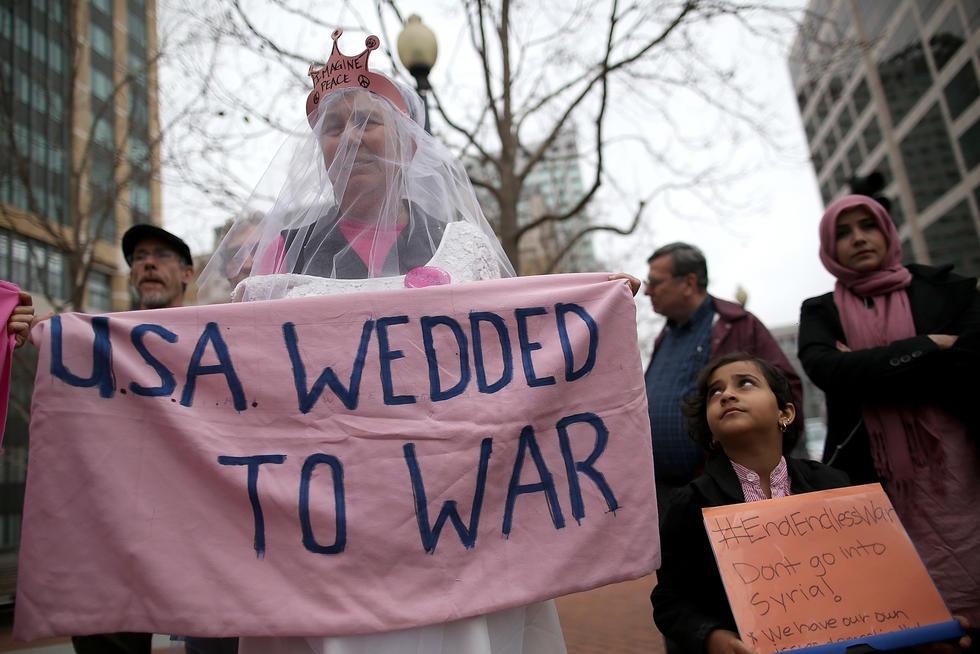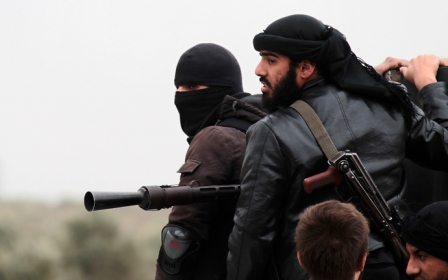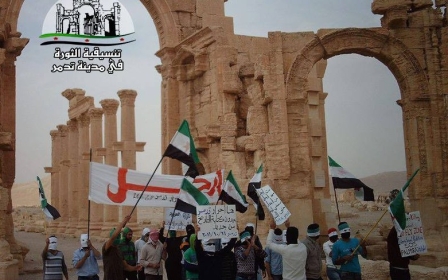Pentagon report says West, Gulf states and Turkey foresaw emergence of ‘IS’

A newly declassified Pentagon report provides startling high-level confirmation that the US-led strategy in Syria contributed directly to the rise of the Islamic State (IS).
The secret US Defence Intelligence Agency (DIA) document, obtained by Washington DC law firm Judicial Watch, reveals that the emergence of an “Islamic State” across Iraq and Syria was foreseen by the Pentagon, as early as three years ago.
According to the internal report, which was distributed throughout the US intelligence community, this was seen as a likely consequence of the West’s efforts to destabilise Bashar al-Assad’s regime in Syria.
Despite that, Western governments continued to coordinate financial, military and logistical support to largely Islamist militant rebel groups in Syria, through allies Saudi Arabia, Qatar, UAE, Jordan and Turkey, among others.
A sectarian insurgency
Dated August 2012, the report states that the “major forces driving the insurgency in Syria” comprise “the Salafist, the Muslim Brotherhood, and AQI [al-Qaeda in Iraq].”
Immediately after, the document states that these forces are being supported by a Western-led coalition: “The West, Gulf countries and Turkey support the opposition.”
Throughout, the document does not suggest a distinction between "moderate" Free Syrian Army (FSA) rebels and Islamist militant groups, nor between the insurgency and the opposition.
Rather, the document shows that opposition forces engaged in fighting the Assad regime consisted of a combination of overlapping Islamist forces. Singling out al-Qaeda in Iraq (AQI), the document says the terror group “supported the Syrian opposition from the beginning” due to its belief that Assad was “targeting Sunnis”.
The report further describes the insurgency as a “sectarian uprising,” whose increasingly sectarian character attracts “volunteers” from across the region to “support the Sunnis in Syria”.
In the same month the DIA report was written, the BBC, Associated Press and other news outlets reported increasing incidents of sectarian atrocities against Shia civilians by FSA rebels, demonstrating the FSA’s growing penetration by sectarian Islamist groups.
In his recent blog post, however, Middle East expert Professor Juan Cole denies that the document says the US “created” sectarian groups in Syria. This is beside the point – the document affirms that despite awareness of the increasingly “sectarian direction” of an insurgency driven significantly by al-Qaeda, the US and its allies still supported it.
Western backing for al-Qaeda
Earlier the same year, CIA officials were in southern Turkey overseeing the supply of Turkish, Saudi and Qatari-financed weapons to purportedly "moderate" rebels. The CIA was “helping allies decide which Syrian opposition fighters” would receive arms.
By the following year, defence consultancy IHS Jane concluded based on Western intelligence estimates that nearly half of all Syrian rebels were Islamist jihadists, who shared al-Qaeda’s outlook except for being focused on the Syrian conflict.
Cole scoffs at the idea that the US would “support al-Qaeda linked groups” – and that the DIA document might internally acknowledge the same.
Yet that is exactly what the West’s allies – the Gulf states and Turkey – were doing, under the close supervision of the CIA and MI6.
In 2014, a senior Qatari official revealed that Qatar and Saudi Arabia had for years provided economic and military assistance primarily to al-Qaeda’s Syrian arm, Jabhat al-Nusra, and to the IS precursor, the Islamic State in Iraq and Syria (ISIS).
Prosecutor and witness testimony in court documents showed that in the same period, Turkey’s state intelligence agency (MIT) was supplying weapons by truck to al-Qaeda and ISIS-controlled rebel areas in Syria.
Such Saudi, Qatari and Turkish support for al-Qaeda and ISIS was not news to US intelligence. Back in late 2012, classified US intelligence assessments made available to President Obama and senior policymakers showed that most Saudi and Qatari arms went to “hard-line Islamic jihadists, and not the more secular opposition groups”.
And despite official declarations of being able to certify support to "moderates" as opposed to extremists, last year the State Department was unable to identify a single "moderate" rebel group in receipt of Western support.
The failure of secular rebel groups “to secure regular arms supplies,” reported the New York Times, “has allowed Islamists to fill the void and win supporters”. Consequently, rebel-held areas across Syria were “dotted with Islamic courts staffed by lawyers and clerics,” who want to “infuse Islamic law into a future Syrian government”.
The strategy allowed Islamist militants to hijack the grassroots Syrian revolution and crushed all prospects of an inclusive, democratically elected government.
Who wanted a ‘Salafist Principality’ ?
By early 2013, al-Qaeda had taken control of Syrian government oil fields in Hasaka and Deir Ezzor, today the de facto IS capital.
The August 2012 DIA document reveals that the Pentagon anticipated this outcome, and spurred it forward. Noting that “the opposition forces are trying to control the eastern areas (Hasaka and Deir Ezzor),” the document observed how “Western countries, the Gulf states and Turkey are supporting these efforts”.
The report warned explicitly that a rebel conquest of Hasaka and Deir Ezzor would likely spawn a militant Islamist political entity in eastern Syria:
“If the situation unravels there is the possibility of establishing a declared or undeclared Salafist Principality in eastern Syria (Hasak and Der Zor), and this is exactly what the supporting powers want, in order to isolate the Syrian regime, which is considered the strategic depth of the Shia expansion (Iraq and Iran).”
This extraordinary passage confirms that at least three years ago, the Pentagon anticipated the rise of a “Salafist Principality” as a direct consequence of its Syria strategy – and that the “supporting powers” behind the rebels “wanted” this outcome “to isolate the Syrian regime,” and weaken Shiite influence via Iraq and Iran.
Who were the “supporting powers?” According to Juan Cole, this refers to “those powers (e.g. Turkey and the Gulf monarchies) supporting the opposition.” He adds: “It doesn’t say the US or ‘the West’ wanted to see such a thing.”
This is a selective, and false, reading. Cole ignores that the sentences of the report mentioning Turkey and the Gulf States as “supporting powers,” all begin with “the West”:
“The West, the Gulf countries, and Turkey support the opposition.”
And three paragraphs before the mention of a “Salafist Principality”: “Western countries, the Gulf states and Turkey are supporting these efforts.”
The clear import of this precise language in the DIA report is that the “West, the Gulf countries, and Turkey” were not acting in isolation, but as a single coalition under Western leadership.
Similarly, Robert Barsocchini speculates that “supporting powers” might refer to al-Qaeda in Iraq. However, the US intelligence community does not classify AQI or any other non-state terrorist network as a “power”.
The use of the plural, “supporting powers,” clarifies that the reference is to a group of powers supporting the rebels, not just one entity like AQI.
Barsocchini, like Cole, also suggests that Western governments would not admit to wanting a "Salafist Principality," even privately. This is incorrect. Declassified files since World War II prove that Western governments frequently and privately admit to cultivating Islamist extremism for geopolitical reasons.
In summary, the Pentagon report is absolutely clear that the West, the Gulf states and Turkey were supporting the Syrian opposition to attain a common goal: the emergence of a “Salafist” political entity in eastern Syria that would help “isolate” Assad.
Anticipating ISIS
The Pentagon document cautioned that if such an Islamist entity did appear in eastern Syria, it could have “dire consequences” for Iraq, providing “the ideal atmosphere for AQI to return to its old pockets in Mosul and Ramadi,” and a “renewed momentum” for a unified jihad “among Sunni Iraq and Syria”.
Most strikingly, the report warned:
“ISI could also declare an Islamic State through its union with other terrorist organisations in Iraq and Syria, which will create grave danger in regards to unifying Iraq and the protection of its territory.”
So in 2012, the US intelligence community knew that an al-Qaeda victory over Hasaka and Deir al-Zour would likely facilitate the installation of an Islamist-Salafist entity, that its own allies - at least - wanted exactly that outcome, and that this outcome would create “the ideal atmosphere” for “AQI” and “ISI” to expand and even “declare an Islamic State” in Iraq and Syria, that could fracture Iraq.
Subsidising ISIS
So what did the Pentagon do in response to this information?
It escalated the strategy.
Even assuming the validity of Cole’s unilateral redaction of “the West” from the “supporting powers” behind the rebels, the implication is unchanged: in 2012, the Pentagon knew that its own allies, who were supplying arms to the rebels with CIA approval, wanted to see the emergence of an Islamist-Salafist political structure in eastern Syria.
Despite this, and despite ongoing intelligence updates proving that their allies were not funding "moderates" – instead supporting their favoured Islamist terrorists – US and European intelligence advisers on the ground simply continued on the same course.
No sooner had al-Qaeda and ISIS rebels conquered the eastern Syrian oil fields in Hasaka and Deir Ezzor in April 2013, they received direct Western financial support: the European Union voted to ease an embargo on Syria to allow the oil to be sold on international markets to European companies, with transactions approved by the FSA’s political overseers, the Syrian National Coalition.
“The logical conclusion from this craziness is that Europe will be funding al-Qaeda,” said Joshua Landis, a Syria expert at the University of Oklahoma.
Unsurprisingly, these al-Qaeda and ISIS inspired rebels supported by the Western-led coalition had an authoritarian theocratic agenda, distinct from the “many civilian activists, protesters and aid workers who had hoped the uprising would create a civil, democratic Syria.”
By September 2014, the EU’s ambassador to Iraq, Jana Hybaskova, complained to the Foreign Affairs Committee that “several EU member states have bought oil from the Islamic State (IS, formerly ISIS) terrorist organisation that has been brutally conquering large portions of Iraq and Syria”.
So from early 2013 to late 2014, the West was bankrolling the jihadist-run "Salafist Principality" in eastern Syria through oil imports, fully cognisant that this entity posed a “grave danger” of galvanising the rise of an Islamic State across Iraq and Syria.
The Pentagon cannot pretend it didn’t know the consequence of its strategy. Indeed, it doesn’t.
When asked repeatedly by journalist and ex-US marine Brad Hoff to dispel claims that the West aligned itself with IS or ISIS at some point in Syria, the DIA’s official response was telling: “No comment.”
- Nafeez Ahmed PhD is an investigative journalist, international security scholar and bestselling author who tracks what he calls the 'crisis of civilization.' He is a winner of the Project Censored Award for Outstanding Investigative Journalism for his Guardian reporting on the intersection of global ecological, energy and economic crises with regional geopolitics and conflicts. He has also written for The Independent, Sydney Morning Herald, The Age, The Scotsman, Foreign Policy, The Atlantic, Quartz, Prospect, New Statesman, Le Monde diplomatique, New Internationalist. His work on the root causes and covert operations linked to international terrorism officially contributed to the 9/11 Commission and the 7/7 Coroner’s Inquest.
The views expressed in this article belong to the author and do not necessarily reflect the editorial policy of Middle East Eye.
Photo: Demonstrators hold signs during a news conference in front of the Oakland Federal Building to speak out against military campaigns on 17 February in Oakland, California (AFP)
New MEE newsletter: Jerusalem Dispatch
Sign up to get the latest insights and analysis on Israel-Palestine, alongside Turkey Unpacked and other MEE newsletters
Middle East Eye delivers independent and unrivalled coverage and analysis of the Middle East, North Africa and beyond. To learn more about republishing this content and the associated fees, please fill out this form. More about MEE can be found here.





